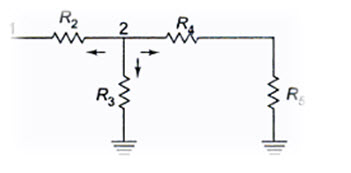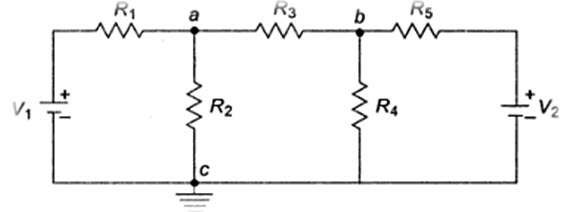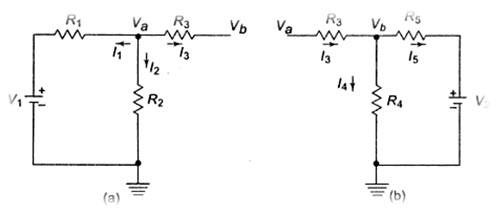Site pages
Current course
Participants
General
Module 1. Average and effective value of sinusoida...
Module 2. Independent and dependent sources, loop ...
Module 3. Node voltage and node equations (Nodal v...
Module 4. Network theorems Thevenin’ s, Norton’ s,...
Module 5. Reciprocity and Maximum power transfer
Module 6. Star- Delta conversion solution of DC ci...
Module 7. Sinusoidal steady state response of circ...
Module 8. Instantaneous and average power, power f...
Module 9. Concept and analysis of balanced polypha...
Module 10. Laplace transform method of finding ste...
Module 11. Series and parallel resonance
Module 12. Classification of filters
Module 13. Constant-k, m-derived, terminating half...
LESSON 6. Node voltage and node equation (Nodal voltage method)
6.1. Nodal Analysis
In the previous chapter we discussed simple circuits containing only two nodes, including the reference node. In general, in a N node circuit, one of the nodes is choosen as reference or datum node, then it is possible to write N – 1 nodal equations by assuming N – 1 node voltages. For example, a 10 node circuit requires nine unknown voltages and nine equations. Each node in a circuit can be assigned a number or a letter. The node voltage is the voltage of a given node with respect to one particular node, called the reference node, which we assume at zero potential. In the circuit shown in Fig.6.1, node 3 is assumed as the reference node. The voltage at node 1 is the voltage at that node with respect to node 3. Similarly, the voltage at node 2 is the voltage at that node with respect to node 3. Applying Kirchhoff’s current law at node 1; the current entering is equal to the current leaving. (See Fig. 6.2).

Fig. 6.1 Fig. 6.2
\[{I_1}={{{V_1}} \over {{R_1}}} + {{{V_1} - {V_2}} \over {{R_2}}}\]
whereV1 and V2 are the voltages at node 1 and 2, respectively. Similarly, at node 2, the current entering is equal to the current leaving as shown in Fig. 6.3.
\[{{{V_2} - {V_1}} \over {{R_2}}} + {{{V_2}} \over {{R_3}}} + {{{V_2}} \over {{R_4} + {R_5}}}=0\]
Rearranging the above equations, we have

Fig. 6.3
\[{V_1}\left[ {{1 \over {{R_1}}} + {1 \over {{R_2}}}} \right] - {V_2}\left[ {{1 \over {{R_2}}}} \right]={I_1}\]
\[-{V_1}\left[ {{1 \over {{R_2}}}} \right] + {V_2}\left[ {{1 \over {{R_2}}} + {1 \over {{R_3}}} + {1 \over {{R_4} + {R_5}}}} \right]=\,0\]
6.2. Nodal Equations by Inspection Method
The nodal equations for a general planar network can also be written by inspections, without going through the detailed steps. Consider a three node resistive network,, including the reference node, as shown in Fig.6.4.

Fig.6.4
In Fig.6.4, the points a andb are the actual nodes and c is the reference node. Now consider the nodes a andb separately as shown in Fig. 6.5 (a) and (b).

Fig.6.5
In Fig.6.5 (a), according to Kirchhoff’s current law, we have
I1 + I2 + I3 = 0
\[{{{V_a} - {V_1}} \over {{R_1}}} + {{{V_a}} \over {{R_2}}} + {{{V_a} - {V_b}} \over {{R_3}}} = 0...................................................\left( {6.1} \right)\]
In Fig.6.5 (b), if we apply Kirchhoff’s current law, we get
I4 + I5 = I3
\[{{{V_b} - {V_a}} \over {{R_3}}} + {{{V_b}} \over {{R_4}}} + {{{V_b} - {V_2}} \over {{R_5}}} = 0...................................................\left( {6.2} \right)\]
Rearranging the above equations, we get
\[\left( {{1 \over {{R_1}}} + {1 \over {{R_2}}} + {1 \over {{R_3}}}} \right){V_a} - \left( {{1 \over {{R_3}}}} \right){V_b}=\left( {{1 \over {{R_1}}}} \right){V_1}...................................................\left( {6.3} \right)\]
\[-\left( {{1 \over {{R_3}}}} \right){V_b} + \left( {{1 \over {{R_3}}} + {1 \over {{R_4}}} + {1 \over {{R_5}}}} \right){V_b}=\left( {{{{V_2}} \over {{R_5}}}} \right)...................................................\left( {6.4} \right)\]
In general, the above equations can be written as
\[{G_{aa}}\,\,\,{V_a} + \,{G_{ab}}\,\,{V_b}={I_1}...................................................\left( {6.5} \right)\]
\[{G_{ba}}\,\,\,{V_a} + \,{G_{bb}}\,\,{V_b}={I_2}...................................................\left( {6.6} \right)\]
By comparing Eqs.6.3, 6.4 and Eqs.6.5, 6.6 we have the self-conductance at node \[a,\,{G_{aa\,}}=\,\left( {1/{R_1} + 1/{R_2} + 1/{R_3}} \right)\] is the sum of the conductance connected to node a. Similarly, \[\,{G_{bb\,}}=\,\left( {1/{R_3} + 1/{R_4} + 1/{R_5}} \right)\] , is the sum of the conductance connected to node b. \[\,{G_{ab\,}}=\,\left( { - 1/{R_3}} \right)\] is the sum of the mutual conductance connected to node a and node b. Here the entire mutual conductance has negative signs. Similarly, \[\,{G_{ba\,}}=\,\left( { - 1/{R_3}} \right)\] is also a mutual conductance connected between nodes b and a. I1 and I2 are the sum of the source currents at node a and node b, respectively. The current which drives into the node has positive sign, while the current that drives away from the node has negative sign.